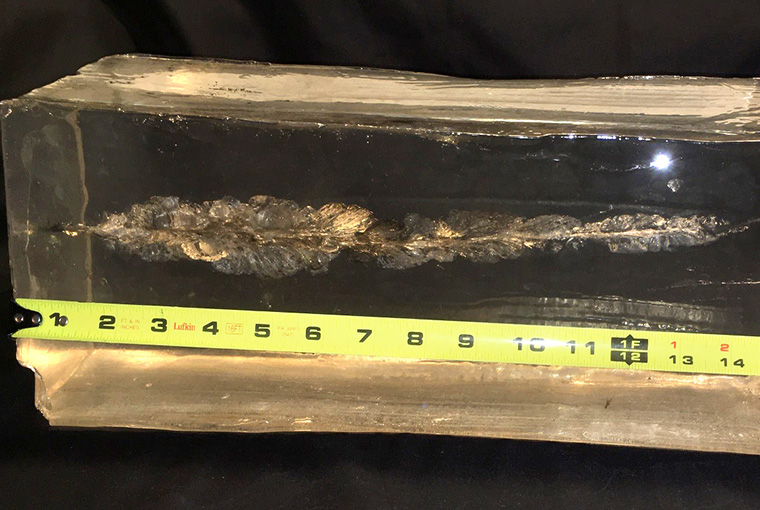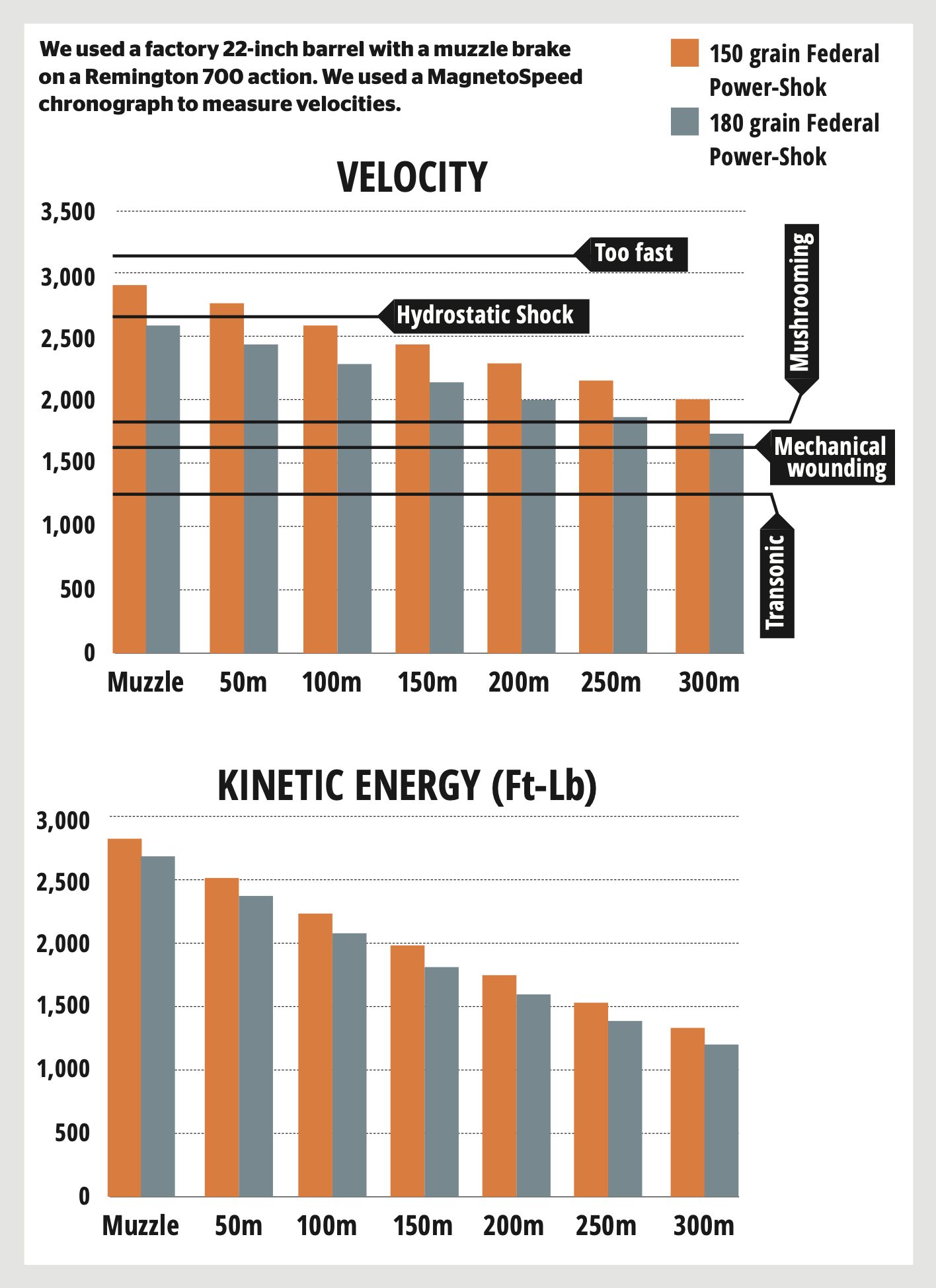
It’s common for hunters to think that a bigger bullet is better. In the old days, it was mostly true. A bigger chunk of lead usually did more damage than a smaller one. To see if this is true today, we dug deeper and did some testing.
Assessing the main factors
Fast is good, and faster is better, until it’s too fast. We tested Federal Power-Shok in our ordinary .308 hunting rifle. As you can see from the first chart, the little 150-grain bullet was faster than the 180-grain bullet and retained more velocity through normal hunting distances.
Velocity is the driving factor for hydrostatic shock (which produces a quick kill). According to an extensive ballistic study published by Terminal Ballistics Research, in moderate bore sizes (.243 to .338) you need 2,600 feet per second (fps) or more to produce hydrostatic shock. The 180-grain bullet in our test had a muzzle velocity of 2,591 fps and would not produce hydrostatic shock at any distance.
Brian Litz, well known for ballistic studies, says 1,800 fps of terminal velocity is typically required for proper bullet expansion. And when the bullet gets close to going to the subsonic range (starting at 1,339 fps), it has questionable stability.
Velocity also has a profound effect on hydraulic shock which is important in the size of the internal wound channel. Good hunting bullets can make an effective wound channel down to about 1,600 fps.

We used a factory 22-inch barrel with a muzzle brake on a Remington 700 action. We used a MagnetoSpeed chronograph to measure velocities.
What’s too fast?
Experts say you don’t want your medium-game bullets going faster than 3,150 fps or you may risk shallow penetration (picture the bullet going “splat” on the side of the animal). You need more bullet weight so that the bullet can break through the surface tension of water within the animal. Faster bullets can be used for varmints because penetration and expansion needs to be almost simultaneous. The flatter trajectory is also important on small targets.
Terminal energy matters
Velocity is the main contributing factor to kinetic energy, which packs the punch that makes quick ethical kills. In a given calibre, the lighter bullet is faster and so it can produce more kinetic energy.
In our test, the 150-grain bullet was fast enough to produce more kinetic energy than the 180-grain bullet. It retained that power throughout the normal hunting distances.
Just to put those numbers in perspective, many experts say to kill a deer ethically takes terminal energy of 1,000 foot pounds (ft-lb), some say 800 ft-lb, and others commonly quote 1300 ft-lb. In Africa, they require 2,700 J (1,991 ft-lb) for game animals which are 100-200 kg, i.e., about the size of a large whitetail or a six-month-old moose calf.
Penetration and expansion
Bullet penetration before expansion is dependent on bullet design and velocity on contact. The bullet needs to enter the animal and expand in the vitals. It’s important that you pick a bullet that’s designed to give you the penetration and expansion needed for the game you are hunting.
The bullet’s performance depends on terminal velocity. Each given bullet design has its preferred velocity range. This is one reason hunting ammo usually states what distances it’s good for. It’ll punch holes in paper at any distance, but the bullet is depending on having a specific velocity to properly penetrate and expand on game.
Bullet manufacturers provide this info. For example, Nosler says their Accubonds need a mini- mum 1,800 fps to expand properly, whereas their Accubond LRs need only 1,300 fps.
If you know your muzzle velocity, there are ballistic apps that will tell you the bullet velocity at various distances. Otherwise, stick to what the manufacturer says.
Our test
One of the things you don’t see mentioned very often in hunting articles is the release of energy in the animal. The technical ballisticians refer to this as the hydraulic shock we discussed earlier.
When we shoot into a ballistic gel block, we can capture on video the temporary wound channel which shows the release of energy from the bullet. What you see when you butcher the meat (and in the still images of the gel blocks) is the permanent wound channel.
What we’ve also found is that the bullets with more terminal energy often break the board or table that we’ve used under the gel blocks. The force to do this is enormous and indicates the force to which the animal is subject.

The 150-grain bullet (above, left) at 50 meters released most of its energy in the first half of the gel block (main burst of energy from two to eight inches and traveled a total of 17 inches.
The 180-grain bullet at 50 meters released most of its energy over a longer stretch (from two to 14 inches) and traveled a total of 19.5 inches.
The better choice
We’ve often been asked by hunters why their 180- grain bullets seem to go through deer like a full-metal jacket. For typical Ontario deer hunting, the lighter faster bullet is a better choice.
The kinetic energy of the bullet is a product of the velocity and the bullet mass. Generally speaking, the formula to calculate kinetic energy is 1/2 mass times velocity squared. To calculate muzzle energy, we used the Bullet Kinetic Energy Calculator at www.shooterscalculator.com.

Originally published in Ontario OUT of DOORS’ 2021-2022 Hunting Annual.
Linda and Keith own and operate the MilCun Training Centre (www.milcun.com) near Haliburton, Ontario. They are the authors of the bestselling books The Wind Book for Rifle Shooters and The Secrets of Mental Marksmanship. Reach Linda or Keith at mail@oodmag.com.
